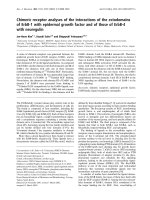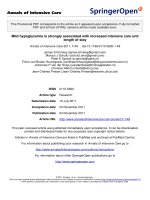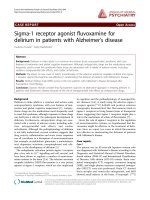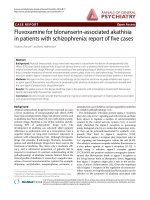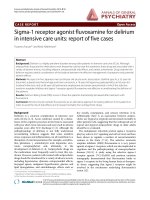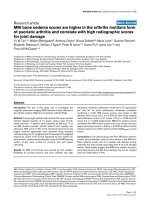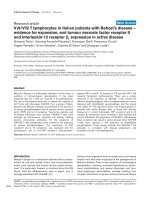Báo cáo y học: "Sigma-1 receptor agonist fluvoxamine for delirium in intensive care units: report of five cases" doc
Bạn đang xem bản rút gọn của tài liệu. Xem và tải ngay bản đầy đủ của tài liệu tại đây (300.82 KB, 4 trang )
Furuse and Hashimoto Annals of General Psychiatry 2010, 9:18
/>Open Access
CASE REPORT
BioMed Central
© 2010 Furuse and Hashimoto; licensee BioMed Central Ltd. This is an Open Access article distributed under the terms of the Creative
Commons Attribution License ( which permits unrestricted use, distribution, and repro-
duction in any medium, provided the original work is properly cited.
Case report
Sigma-1 receptor agonist fluvoxamine for delirium
in intensive care units: report of five cases
Tsutomu Furuse*
1
and Kenji Hashimoto
2
Abstract
Background: Delirium is a highly prevalent disorder among older patients in intensive care units (ICUs). Although
antipsychotic drugs are the medications most frequently used to treat this syndrome, these drugs are associated with a
variety of adverse events, including sedation, extrapyramidal side effects, and cardiac arrhythmias. Drug treatment for
delirium requires careful consideration of the balance between the effective management of symptoms and potential
adverse effects.
Methods: We report on five Japanese men (an 84 year old (acute aortic dissociation: Stanford type A), a 55 year old
(traumatic subarachnoid hemorrhage and brain contusion), a 76 year old (sepsis by pyelonephritis), an 85 year old
(cerebral infarction), and an 86 year old (pulmonary emphysema and severe pneumonia)) in which the selective
serotonin reuptake inhibitor and sigma-1 receptor agonist fluvoxamine was effective in ameliorating the delirium of
the patients.
Results: Delirium Rating Scale (DRS) scores in these five patients dramatically decreased after treatment with
fluvoxamine.
Conclusion: Doctors should consider fluvoxamine as an alternative approach to treating delirium in ICU patients in
order to avoid the risk of side effects and increased mortality from antipsychotic drugs.
Background
Delirium is a common complication in intensive care
units (ICUs) [1-3]. Acute syndrome caused by a distur-
bance of the cognitive processes in the brain is associated
with poor short-term outcomes and may result in adverse
sequelae years after ICU discharge [1-3]. Although the
pathophysiology of delirium is not fully understood,
accumulating evidence suggests that acute oxidative
stress responses and inflammation can all contribute to a
disruption of neurotransmission (for example, acetylcho-
line, glutamate, γ -aminobutyric acid, dopamine, sero-
tonin, norepinephrine) and, ultimately, to the
development of delirium [1-4]. Antipsychotic drugs are
the medications most frequently used to treat this syn-
drome. However, patients with treated with antipsychotic
drugs should be monitored for a variety of adverse events,
including hypotension, dystonia, extrapyramidal effects,
laryngeal spasm, malignant hyperthermia, glucose and
lipid dysregulation, and anticholinergic effects such as
dry mouth, constipation, and urinary retention [1-4].
Additionally, there is an association between antipsy-
chotic use (typical or atypical) and increased mortality in
older patients [5,6], suggesting that the widespread use of
typical and atypical antipsychotic drugs in older adults
should be re-evaluated.
The endoplasmic reticulum protein sigma-1 receptors
play key roles in Ca
2+
signaling and cell survival, and have
been shown to regulate a number of neurotransmitter
systems in the brain [7-11]. The selective serotonin
reuptake inhibitor (SSRI) fluvoxamine is a very potent
agonist at sigma-1 receptors, which are also implicated in
cognition and the pathophysiology of neuropsychiatric
diseases [10,11]. A study using the selective sigma-1
receptor agonist [
11
C]-SA4503 and positron emission
tomography demonstrated that fluvoxamine binds to
sigma-1 receptors in the living human brain at therapeu-
tic doses, suggesting that sigma-1 receptors might be
involved in the mechanism underlying fluvoxamine's
action [12].
* Correspondence:
1
Department of Psychiatry, Asahikawa Red Cross Hospital, Asahikawa, Japan
Full list of author information is available at the end of the article
Furuse and Hashimoto Annals of General Psychiatry 2010, 9:18
/>Page 2 of 4
Given the important role of sigma-1 receptors in the
regulation of neurotransmitter systems, we have a
hypothesis that fluvoxamine might be effective in the
treatment of delirium. Very recently, we reported two
cases showing that fluvoxamine was effective in amelio-
rating the delirium of patients with Alzheimer's disease
[13]. Here, we report five cases in which fluvoxamine was
also effective in the treatment of delirium in ICU
patients.
Case reports
Table 1 shows the characteristics of five ICU patients
with delirium.
Case 1
An 84-year-old Japanese man was admitted to a hospital's
emergency medical center with a complaint of stomach
ache. The patient was diagnosed with acute aortic disso-
ciation (Stanford type A) and treated in the ICU. An anal-
gesic effect of pentazocine was observed. However, he
had sleep disturbance in the night, and the patient's topic
of conversation was inappropriate. Therefore, he was
referred to the hospital's department of psychiatry. There,
he was disoriented and agitated. To treat his delirium, he
was administered fluvoxamine (50 mg, twice a day) and
flunitrazepam (1 mg, at night). At 1 day after treatment,
his sleep disturbance improved, and his Delirium Rating
Scale (DRS) [14] score decreased dramatically from 16/32
to 6/32. After ICU discharge, his condition was good. His
Mini-Mental State Examination (MMSE) [15] score was
25/30.
Case 2
A 55-year-old Japanese man fell from a ladder while
working, and a resulting bruise on his head impaired his
consciousness. He was admitted to the hospital's emer-
gency medical center. The patient was diagnosed with
traumatic subarachnoid hemorrhage and brain contusion
by brain computed tomography (CT) and magnetic reso-
nance imaging (MRI). His level of consciousness on the
Glasgow Coma Scale [16] in the emergency room was 13/
15. His grasp of consciousness was shaky, and he shouted
suddenly, whereupon he was referred to the department
of psychiatry. He was disoriented, and uttered inappro-
priate comments. To treat his delirium, fluvoxamine (50
mg, twice a day) and flunitrazepam (1 mg, at night) were
added. At 1 day after treatment, his sleep disturbance
improved, and his DRS score dramatically decreased
from 20/32 to 10/32. After rehabilitation, he recovered
gradually. His MMSE score just before discharge was 25/
30.
Case 3
A 76-year-old Japanese man was admitted to a hospital's
emergency medical center with a fever of 40°C and in a
twilight state. His body CT showed a right kidney stone,
and he was diagnosed with sepsis from pyelonephritis. At
night time, he became excited and removed his intrave-
Table 1: Demographic, clinical, and symptom characteristics of patients with delirium who responded to fluvoxamine
Case Gender (F/M) Age (years) Diagnosis Dose of
fluvoxamine
DRS before
treatment
DRS after
treatment
1M84Acute aortic
association
50 mg 16/32 6/32 (1 day)
2 M 55 Traumatic
subarachnoid
hemorrhage,
brain
contusion
50 mg 20/32 10/32 (1 day)
3 M 76 Sepsis by
pyelonephritis
50-150 mg 21/32 10/32 (3 days)
4M85Cerebral
infarction
50 mg 19/32 10/32 (1 day)
5M86Pulmonary
emphysema,
severe
pneumonia
50-100 mg 18/32 6/32 (2 days)
DRS = Delirium Rating Scale.
Furuse and Hashimoto Annals of General Psychiatry 2010, 9:18
/>Page 3 of 4
nous infusion line, whereupon he was referred to the
department of psychiatry. He was disoriented and could
not remember why he was in the hospital. A brain CT
showed brain atrophy and ventricular enlargement. He
had delirium associated with cognitive impairment. To
treat the delirium, fluvoxamine (50 mg, twice a day) and
flunitrazepam (1 mg, at night) were added. His sleep dis-
turbance improved, but he became agitated. His fluvox-
amine dosage was therefore increased to 100 mg and
then, the next day, to 150 mg. At 3 days after the start of
treatment, his DRS score decreased dramatically from
21/32 to 10/32. His MMSE score just before discharge
was 22/30.
Case 4
An 85-year-old Japanese man was admitted to the emer-
gency medical center with a complaint of languidness on
the left side of his body after he fell in the bathroom at his
home. The patient was diagnosed with cerebral infarction
by brain CT and MRI. At 2 days after hospitalization, he
had sleep disturbance and excitation. He was therefore
referred to the department of psychiatry. He was also dis-
oriented and agitated. To treat his delirium, fluvoxamine
(50 mg, twice a day) and flunitrazepam (1 mg, night) were
added. His sleep disturbance improved. At 1 day after this
treatment, his DRS score decreased dramatically from
19/32 to 10/32. His MMSE score just before discharge
was 22/30.
Case 5
An 86-year-old Japanese man was admitted to our emer-
gency medical center because he had entered a twilight
state after falling in the bathroom at his home. His percu-
taneous arterial oxygen saturation (SpO
2
) level was 80%,
though oxygen was administered with a mask. The
patient was diagnosed with pulmonary emphysema and
severe pneumonia by chest x-ray and chest CT. To treat
the patient's severe pneumonia, antibiotics and steroids
were administered. On the night of his fourth day of hos-
pitalization, he became excited suddenly and said that he
wanted to go home if other people had contempt for him.
He became more excited and booed at a nurse. The next
day, he was referred to the department of psychiatry.
Although he was not disoriented, he had some delusions;
he claimed that a nurse was poisoning his intravenous
drip and that a stranger was spying on him. To treat his
delirium, fluvoxamine (50 mg, twice a day) and fluni-
trazepam (1 mg, at night) were added. The next day, his
fluvoxamine dosage was increased to 100 mg. At 2 days
after the first administration, his DRS score decreased
rapidly, from 18/32 to 6/32. At 1 week after the initiation
of treatment, his fluvoxamine dosage was reduced to 50
mg. His MMSE score just before discharge (after 4 weeks
of hospitalization) was 25/30.
Discussion
To our knowledge, this report is the first to demonstrate
that fluvoxamine is rapidly effective for treating delirium
in ICU patients. Nonetheless, a randomized double-
blind, placebo-controlled study of fluvoxamine will be
needed to confirm its efficacy for the treatment of delir-
ium in ICU patients. Recent findings suggest that sigma-1
receptors might be involved in the different mechanisms
of some SSRIs, and that fluvoxamine is a potent sigma-1
receptor agonist [9-11]. Currently, it is unclear whether
sigma-1 receptors were involved in the mechanism
underlying the beneficial effects of fluvoxamine against
the delirium of these ICU patients. Interestingly, donepe-
zil, a potent sigma-1 receptor agonist [17-19], was
reported to be effective for treating delirium [20-22],
although further studies are necessary. In order to con-
firm the role of sigma-1 receptors in the treatment of
delirium, a randomized double-blind, placebo-controlled
study of the selective sigma-1 receptor agonists (for
example, cutamesine (SA4503)) in ICU patients with
delirium would also be of interest.
Delirium is theorized to be a neurobehavioral manifes-
tation of imbalances in the synthesis, release, and inacti-
vation of a number of neurotransmitters that normally
control cognitive function, behavior, and mood [1-4]. At
present, it is unclear whether fluvoxamine monotherapy
is effective for certain domains of delirium symptoms or
for all delirium symptoms equally. Given the role of
sigma-1 receptors in the regulation of a number of neu-
rotransmitters, as well as in cognition and mood [7-11], it
is likely that sigma-1 receptor agonist may be involved in
the fluvoxamine's mechanisms of action, although further
study will be necessary.
In this study, in all patients a low dose of flunitrazepam
was used for the treatment of insomnia since this drug is
considered to be one of the most effective benzodiaz-
epine hypnotics. Therefore, we cannot exclude a possible
contribution of flunitrazepam to the efficacy of fluvox-
amine for delirium. A further study of fluvoxamine alone
will be necessary. In addition, from the present study, we
cannot exclude a potential contribution of serotonin
transporter inhibition by fluvoxamine to ameliorate delir-
ium in ICU patients. However, it has been reported that
the combination of SSRIs with antipsychotic drug(s) and
concomitant benztropine might increase the risk of delir-
ium in patients. Byerly et al. [23] reported a case showing
delirium associated with sertraline, haloperidol and ben-
zotropine. Furthermore, Armstrong et al. [24] reported a
case of delirium in a patient who was taking benztropine
and paroxetine concomitantly. At present, the precise
mechanisms underlying the incidence of delirium associ-
ated with the combination of sertraline (or paroxetine)
and benztropine are currently unclear. Recent findings
suggest that sigma-1 receptors might be involved in dif-
Furuse and Hashimoto Annals of General Psychiatry 2010, 9:18
/>Page 4 of 4
ferent mechanisms of some SSRIs [10]. Fluvoxamine is a
potent sigma-1 receptor agonist, and sertraline may be a
sigma-1 receptor antagonist [10]. Paroxetine has a very
low affinity at sigma-1 receptors [10]. Taken together, it is
likely that agonism of fluvoxamine at sigma-1 receptors
may be involved in the mechanisms of beneficial effects
of this SSRI although a further detailed study is necessary.
Drug treatment for delirium requires careful consider-
ation of the balance between the effective management of
symptoms and potential adverse effects. As mentioned
above, there is an elevated risk of mortality in older
patients treated with atypical antipsychotics [5,6], sug-
gesting that the widespread use of atypical antipsychotic
drugs in older adults should be re-evaluated. Therefore,
the sigma-1 receptor agonist fluvoxamine may serve as an
alternative treatment option for older adults with delir-
ium, although further detailed studies on the role of
sigma-1 receptors in delirium are necessary.
Conclusions
These five cases suggest that the sigma-1 receptor agonist
fluvoxamine could be an alternative approach to treating
delirium in ICU patients because of the risk of extrapyra-
midal side effects and increased mortality from antipsy-
chotic drugs. More detailed double-blind studies should
be performed to clarify the role of sigma-1 receptors in
the efficacy of fluvoxamine for delirium in ICU patients.
Consent
The patients deteriorated mental status made the
informed consent procedure reasonably difficult. To this
extent consent was obtained from the patient's next-of-
kin and effort has been made so that patient identity
remains anonymous.
Competing interests
The authors declare that they have no competing interests.
Authors' contributions
TF contributed to the clinical and rating evaluations during the follow-up peri-
ods. KH conceived of the study and participated in its study and coordination.
Both authors read and approved the final manuscript.
Author Details
1
Department of Psychiatry, Asahikawa Red Cross Hospital, Asahikawa, Japan
and
2
Division of Clinical Neuroscience, Chiba University Center for Forensic
Mental Health, Chiba, Japan
References
1. Girard TD, Pandharipande PP, Ely EW: Delirium in the intensive care unit.
Crit Care 2008, 12(Suppl 3):S3.
2. Maldonado JR: Delirium in the acute care setting: characteristics,
diagnosis and treatment. Crit Care Clin 2008, 24:657-722.
3. Gunther ML, Morandi A, Ely EW: Pathophysiology of delirium in the
intensive care unit. Crit Care Clin 2008, 24:45-65.
4. Fong TG, Tulebaev SR, Inouye SK: Delirium in elderly adults: diagnosis,
prevention and treatment. Nature Rev Neurol 2009, 5:210-220.
5. Wang PS, Schneeweiss S, Avorn J, Fischer MA, Mogun H, Solomon DH,
Brookhart MA: Risk of death in elderly users of conventional vs. atypical
antipsychotic medications. N Engl J Med 2005, 353:2335-2341.
6. Schneider LS, Dagernab KS, Insel P: Risk of death with atypical
antipsychotic drug treatment for dementia. Meta-analysis of
randomized placebo-controlled trials. JAMA 2005, 294:1934-1943.
7. Hashimoto K, Ishiwata K: Sigma receptor ligands: possible application as
therapeutic drugs and as radiopharmaceuticals. Curr Pharm Des 2006,
12:3857-3876.
8. Hayashi T, Su TP: Sigma-1 receptor chaperones at the ER-
mitochondrion interface regulate Ca
2+
signaling and cell survival. Cell
2007, 131:596-610.
9. Hayashi T, Stahl SM: The sigma-1 receptor and its role in the treatment
of mood disorders. Drugs Future 2009, 34:137-146.
10. Hashimoto K: Sigma-1 receptors and selective serotonin reuptake
inhibitors: clinical implications of their relationship. Cent Nerv Sys
Agents Med Chem 2009, 9:197-204.
11. Ishikawa M, Hashimoto K: The role of sigma-1 receptors in the
pathophysiology of neuropsychiatric diseases. J Receptor Ligand
Channel Res 2010, 3:25-36.
12. Ishikawa M, Ishiwata K, Ishii K, Kimura Y, Sakata M, Naganawa M, Oda K,
Miyatake R, Fujisaki M, Shimizu E, Shirayama Y, Iyo M, Hashimoto K: High
occupancy of sigma-1 receptors in the human brain after single oral
administration of fluvoxamine: a positron emission tomography study
using [
11
C]SA4503. Biol Psychiatry 2007, 62:878-883.
13. Furuse T, Hashimoto K: Sigma-1 receptor agonist fluvoxamine for
delirium in patients with Alzheimer's disease. Ann Gen Psychiatry 2010,
9:6.
14. Trzepacz PT, Baker RW, Greenhouse J: A symptom rating scale for
delirium. Psychiatry Res 1988, 23:89-97.
15. Cockrell JR, Folstein MF: Mini-Mental State Examination (MMSE).
Psychopharmacol Bull 1988, 24:689-692.
16. Teasdale G, Jennett B: Assessment of coma and impaired consciousness.
A practical scale. Lancet 1974, 304:81-84.
17. Ishima T, Nishimura T, Iyo M, Hashimoto K: Potentiation of nerve growth
factor-induced neurite outgrowth in PC12 cells by donepezil: role of
sigma-1 receptors and IP3 receptors. Prog Neuropsychopharmacol Biol
Psychiatry 2008, 32:1656-1659.
18. Kunitachi S, Fujita Y, Ishima T, Kohno M, Horio M, Tanibuchi Y, Shirayama Y,
Iyo M, Hashimoto K: Phencyclidine-induced cognitive deficits in mice
are improved by subsequent subchronic administration of donepezil:
role of sigma-1 receptors. Brain Res 2009, 279:189-193.
19. Ishikawa M, Sakata M, Ishii K, Kimura Y, Oda K, Toyohara J, Wu J, Ishiwata K,
Iyo M, Hashimoto K: High occupancy of sigma-1 receptors in human
brain after single oral administration of donepezil: A positron emission
tomography study using [
11
C]SA4503. Int J Neuropsychopharmacol
2009, 12:1127-1131.
20. Wengel SP, Roccaforte WH, Burke WJ: Donepezil improves symptoms of
delirium in dementia: implications for future research. J Geriatr
Psychiatry Neurol 1998, 11:159-161.
21. Burke WJ, Roccaforte WH, Wengel SP: Treating visual hallucinations with
donepezil. Am J Psychiatry 1999, 156:1117-1118.
22. Wengel SP, Burke WJ, Roccaforte WH: Donepejil for postoperative
delirium associated with Alzheimer's disease. J Am Geriatr Soc 1999,
47:379-380.
23. Byerly MJ, Christensen RC, Evans D: Delirium associated with a
combination of sertraline, haloperidol, and benztropine. Am J
Psychiatry 1996, 153:965-966.
24. Armstrong SC, Schweitzer SM: Delirium associated with paroxetine and
benztropine combination. Am J Psychiatry 1997, 154:581-582.
doi: 10.1186/1744-859X-9-18
Cite this article as: Furuse and Hashimoto, Sigma-1 receptor agonist fluvox-
amine for delirium in intensive care units: report of five cases Annals of Gen-
eral Psychiatry 2010, 9:18
Received: 12 March 2010 Accepted: 24 April 2010
Published: 24 April 2010
This article is available from: 2010 Furuse and Hashimoto; licensee BioMed Central Ltd. This is an Open Access article distributed under the terms of the Creative Commons Attribution License ( ), which permits unrestricted use, distribution, and reproduction in any medium, provided the original work is properly cited.Annals of General Psychiatry 2010, 9:18
